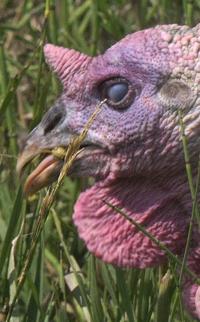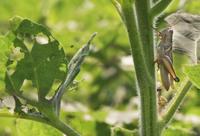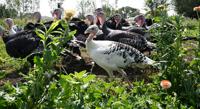Gobble, gobble, crunch: How some farmers have turned to birds to combat the ‘hopperpocalypse’
CAÑON CITY • Hundreds of grasshoppers flutter through the air as Matt Koster wades through his neighbor’s decimated hay field.
Passing through the flattened grass and fog of pests, he reaches his own field. The clouds of insatiable insects seem to dissipate, and the rows of plants stand strong in bloom.
Soon, we see why.
‘Hopperpocalypse: Colorado farmers say this year’s grasshopper infestation the worst in generations
Turkeys, with their pink wattles hanging, race through the field. They’re on the hunt, focused. They stalk their prey, and when spotted, lunge forward with their beaks wide open, pecking and consuming the grasshoppers at an almost supernatural speed.
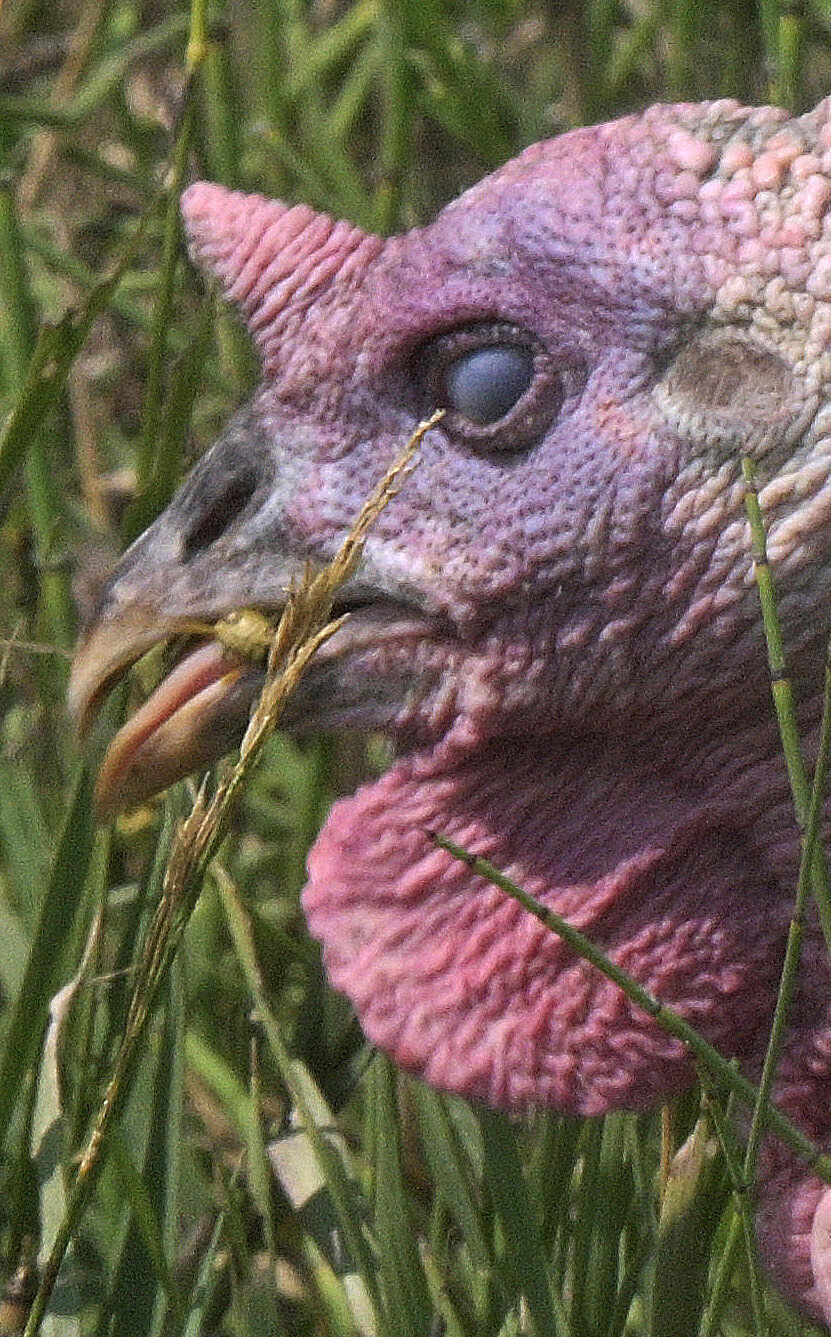
ABOVE: A turkey crunches a snack of a grasshopper.
Jerilee Bennett The Gazette

ABOVE: A turkey crunches a snack of a grasshopper.
Koster herds the fowl through the rows of growth, where they’re quick to pluck their six-legged snacks from the earth.
As the sun rises, the turkeys grow tired and full, huddling together and seeking out shade. Their morning is spent, but later in the evening, they’ll be back on the prowl.
Koster and his partner, Ellen Kerchner, operate Ellen’s Flowers — the largest flower farm in the Pikes Peak region. The farm, which has fields just outside Cañon City, has been plagued by grasshoppers this year in what some farmers have coined the “hopperpocalypse.”
“You wouldn’t think that such a little bug would cause so many problems,” Koster said. “When they reach a critical mass, it’s almost seems like there’s no stopping them.”
The farm has 3-and-a-half acres of field production and 10,000 square feet of greenhouse space. Even outside the greenhouses, grasshopper sit on the metal sides, as if they’re waiting to get in.
Koster is known jokingly as the “turkey wrangler” around the farm. He herds the flower farm’s 20 turkeys, which are made up of two varieties — the robust, broad-breasted black turkey (think Thanksgiving) and the smaller Midget White turkey.
The turkeys act as the farm’s natural pest control. Koster got the idea to use turkeys this year to combat the grasshopper population from his experience working with the animals.
“When I was working with turkeys before, it was at a much larger scale, and so I kind of got the proof of concept early on from that,” he said. “I saw that as we rotated them through different pastures, after the turkeys, there was no grasshoppers.”
A grasshopper ‘explosion’
Last year’s moisture combined with a mild winter brought this year’s storm of hoppers, said Beth Hayes, the agriculture and natural resource specialist at Colorado State University’s Pueblo County Extension. Many of the eggs laid by grasshoppers last year survived the forgiving winter and started hatching in February, even though they normally hatch in April.
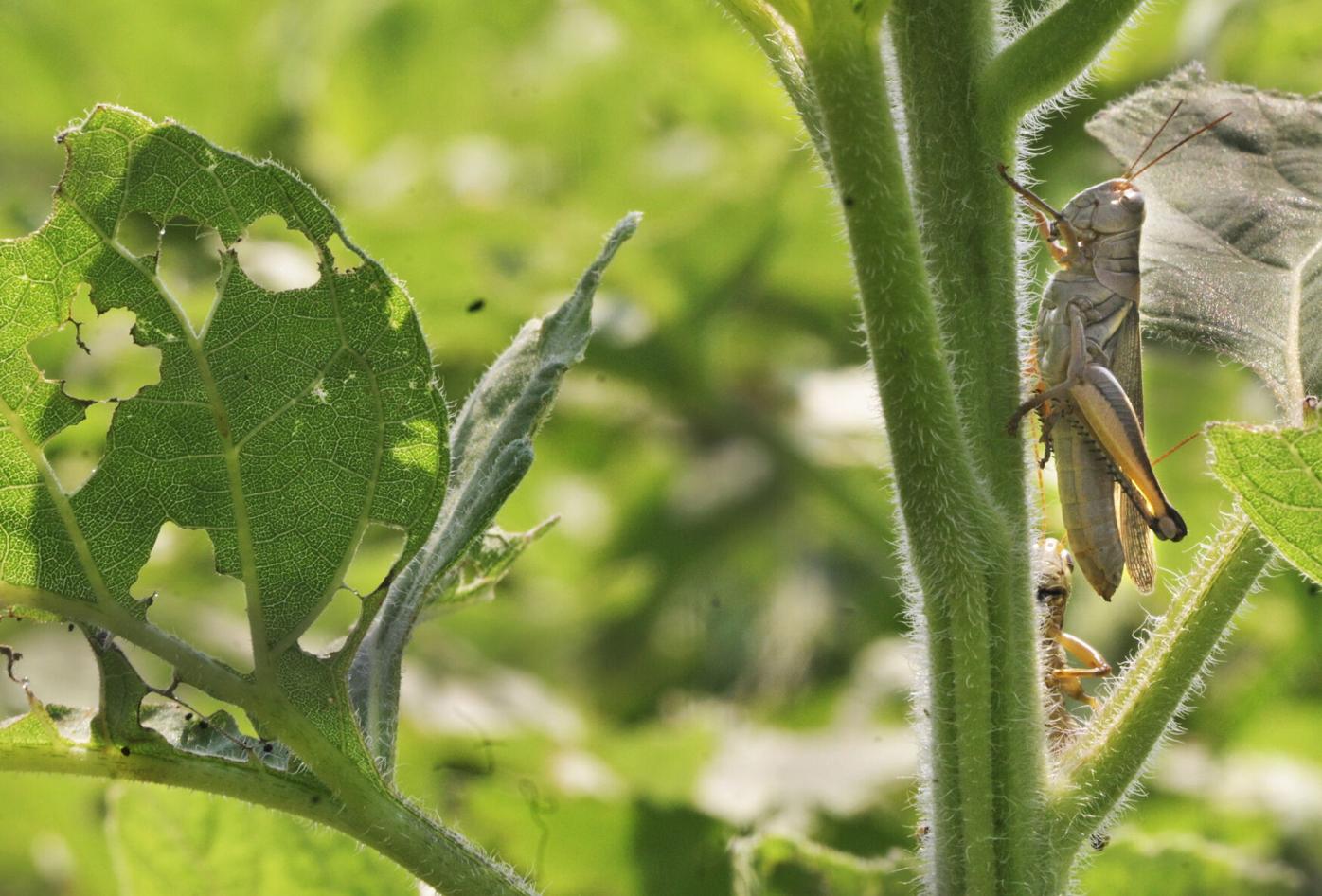
Damage can be seen on a tall sunflower that can’t be reached by the grasshopper-eating turkeys at Ellen’s Flowers, a flower farm in Cañon City.
Jerilee Bennett The Gazette

Damage can be seen on a tall sunflower that can’t be reached by the grasshopper-eating turkeys at Ellen’s Flowers, a flower farm in Cañon City.
“This year, we’ve seen a bigger explosion of their numbers in all species of grasshoppers,” Hayes said. “The problem is, because the numbers have spiked so much again this year, if we don’t do some management techniques in the fall, we’re gonna see it increase even more next year.”
The herbivorous insects decimate plants, from grass to hay — even the bark off trees, Hayes said. She recalled a recent account of a farmer watching the grasshoppers strip and eat the limbs off trees after ravaging the fruits until all that remained were pits.
“They’re causing long-term devastating damage, not only to the fruit, but they’re also damaging trees that are incredibly hard to replace,” Hayes said. “This is setting folks back years and years of work. It’s not just a one-year devastation. It’s multiple years that they’re going to have an impact.”
The pests aren’t just hurting produce farmers, but instead impacting the whole line of food production.
“There’s not enough hay to buy now, which affects all the animals we feed. So that’s all of our dairy cows, all of our cattle, our sheep, our goats, everything that goes into our meat supply,” Hayes said. “There’s nothing to feed them now, and we can’t turn them loose because the grasshoppers have eaten all the native grass.”

At Ellen’s Flowers, a flower farm in Canon City, turkeys have been the key to fighting this Summer’s “hopperpocalypse”. The turkeys have been gobbling up the plague of grasshoppers and saving the flowers from being decimated. Wednesday, July 17, 2024.
Jerilee Bennett The Gazette

At Ellen’s Flowers, a flower farm in Canon City, turkeys have been the key to fighting this Summer’s “hopperpocalypse”. The turkeys have been gobbling up the plague of grasshoppers and saving the flowers from being decimated. Wednesday, July 17, 2024.
There are many methods to mitigate the problem insect, from pesticides to barriers to birds. Solutions vary depending on the farm’s size and goal. Smaller farms tend to rely on more natural techniques. Larger-scale productions often stick with more chemical-based solutions like pesticides. But really, there’s not a cure-all, unfortunately, Hayes said.
Several types of fowl chow on grasshoppers, including chickens, guineas, ducks, geese and turkeys (obviously).
Chickens are probably the worst bird to use for grasshopper mitigation because, well, “they’re not the most selective critter,” Hayes said. The clucking fowl is outfitted with sharp talons, which they often use to dig, making them a bad choice for a garden or farm since they uproot plants.
“If you let them loose in your garden, they will destroy your plant life, not necessarily because they eat it or do it on purpose. It’s just natural chicken behavior. So it works kind of up to a point,” Hayes said. “They will eat everything that they can get.”
Ducks and geese are a little more prolific on eating grasshoppers, Hayes said, and they don’t have the same kind of claw structure, so they don’t cause much damage. Many home gardeners rely on wild birds, placing bird feeders on their property (with little feed) to draw them in, and they’ll naturally go after hoppers.
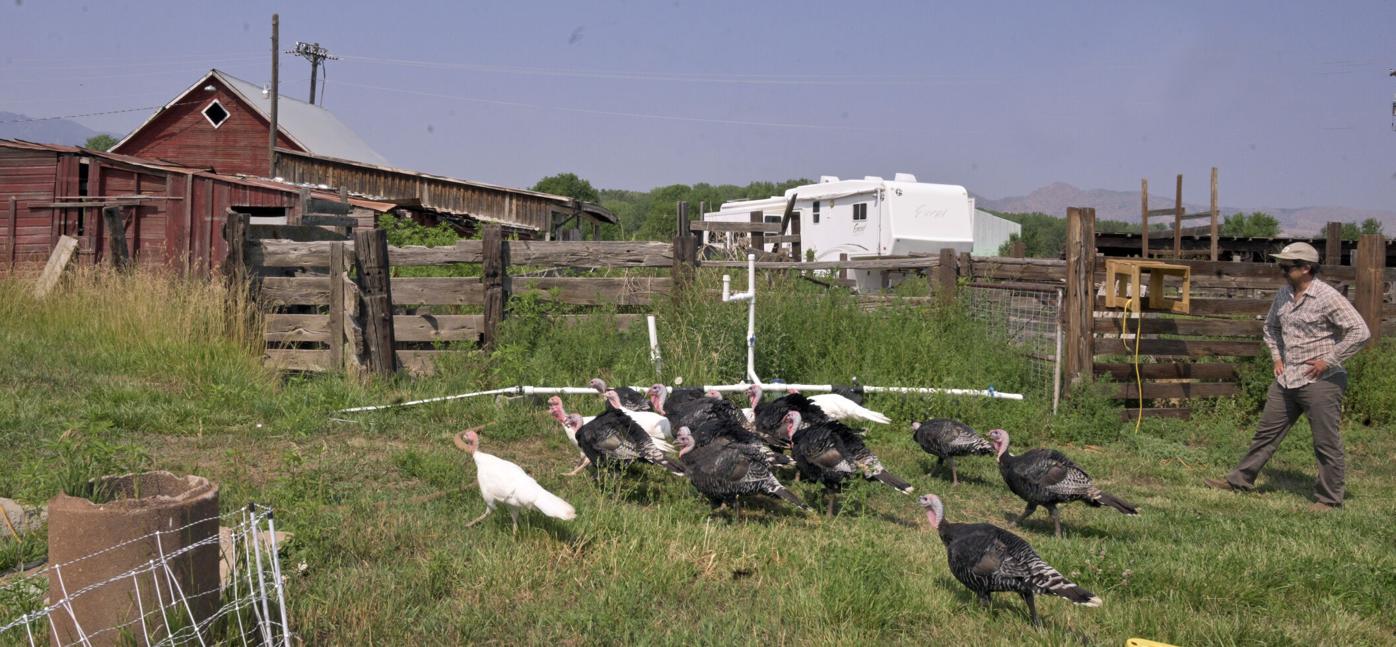
Matt Koster herds his turkeys towards one of the flower gardens at Ellen’s Flowers, a flower farm in Cañon City. Turkeys have been a key weapon against this summer’s “hopperpocalypse.” The turkeys have been gobbling up the plague of grasshoppers and saving flowers from being decimated.
photos by Jerilee Bennett The Gazette

Matt Koster herds his turkeys towards one of the flower gardens at Ellen’s Flowers, a flower farm in Cañon City. Turkeys have been a key weapon against this summer’s “hopperpocalypse.” The turkeys have been gobbling up the plague of grasshoppers and saving flowers from being decimated.
Turkeys are pretty good, Hayes said, but they can be a little picky. But ultimately, birds aren’t going be the end-all-be-all to solve all pest problems, she said.
“If you’re really looking at that as a cure, and not just one tool in your toolbox, it’s not going to have a big enough impact where it’s going to save your garden, your yard, or anything like that,” she said.
When and where to get signature Colorado produce
‘Stewarding the land’
Because of the flower farm’s commitment to ecofriendly and sustainable practices, turkeys seemed the best option to combat this year’s wave of hoppers.
“It’s important to us. We’re farmers, but we think of it as we’re stewarding the land, and that we want to leave it better than it was when we got there,” Koster said. “Our livelihood depends on this earth and the water that we use, and so we want to do everything in our power to protect this piece of ground.”
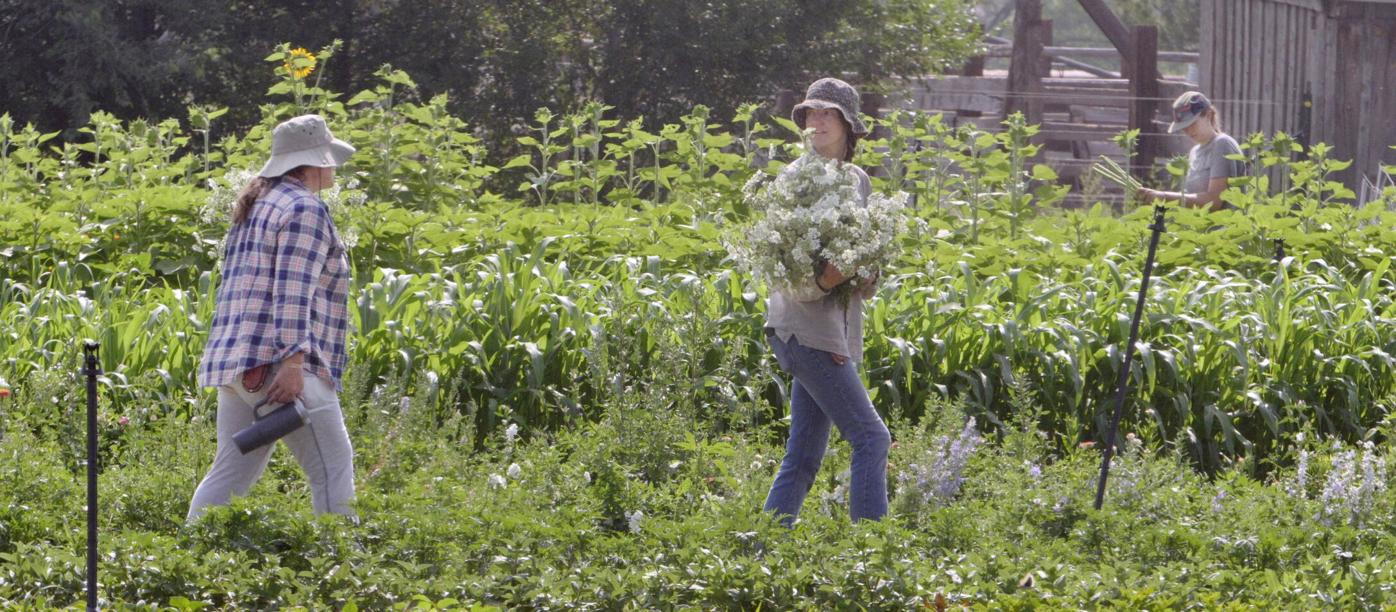
Employees gather flowers at Ellen’s Flowers, a flower farm in Canon City. Turkeys have been the key to fighting this Summer’s “hopperpocalypse”. The turkeys have been gobbling up the plague of grasshoppers and saving the flowers from being decimated. Wednesday, July 17, 2024.
Jerilee Bennett, The Gazette

Employees gather flowers at Ellen’s Flowers, a flower farm in Canon City. Turkeys have been the key to fighting this Summer’s “hopperpocalypse”. The turkeys have been gobbling up the plague of grasshoppers and saving the flowers from being decimated. Wednesday, July 17, 2024.
An important part of Koster’s strategy in using the turkeys as pest control is timing. Koster made sure the chicks would reach adolescence during the first round of grasshoppers hatching.
“Baby chicks, they’re not gonna do anything against them,” Koster said. “When they’re hatching, they’re tiny and they’re kind of awkward, so the turkeys are way more effective then than when the grasshoppers are that big, they’re easier to get away from.”
The turkeys are pretty low maintenance — Koster feeds them an organic supplement and keeps them enclosed in an electric fence at night to protect from predators. Besides that, they’re pretty content running around chasing and eating grasshoppers.
As far as the financial impact, Koster estimates the flower farm lost about $20,000 last year from the jittery pests. But this year, production has remained stable, thanks to the feathered flock.
“We didn’t have them last year, and that really hurt us, that cost us a lot of money,” Koster said.
“It’s difficult to quantify, but they’ve had to have already, at this point in the season, saved, $20,000 in product maybe.”
Next year, Koster has plans to up the herd to 50 turkeys; however, he thinks he’ll just stick to the smaller white variety, since the larger birds can knock over plants when overly determined to snag a hopper.
When the season is done this year, Koster says he has Thanksgiving dinner ready for several family members and friends.





